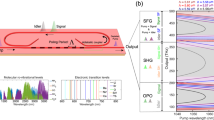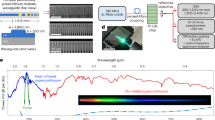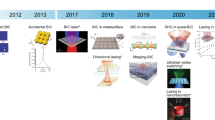Abstract
The ability to spectrally translate lightwave signals in a compact, low-power platform is at the heart of the promise of nonlinear nanophotonic technologies. For example, a device to connect the telecommunications band with visible and short near-infrared wavelengths can enable a connection between high-performance chip-integrated lasers based on scalable nanofabrication technology with atomic systems used for time and frequency metrology. Although second-order nonlinear (χ(2)) systems are the natural approach for bridging such large spectral gaps, here we show that third-order nonlinear (χ(3)) systems, despite their typically much weaker nonlinear response, can realize spectral translation with unprecedented performance. By combining resonant enhancement with nanophotonic mode engineering in a silicon nitride microring resonator, we demonstrate efficient spectral translation of a continuous-wave signal from the telecom band (~1,550 nm) to the visible band (~650 nm) through cavity-enhanced four-wave mixing. We achieve such translation over a wide spectral range >250 THz with a translation efficiency of (30.1 ± 2.8)% and using an ultralow pump power of (329 ± 13) μW. The translation efficiency projects to (274 ± 28)% at 1 mW and is more than an order of magnitude larger than what has been achieved in current nanophotonic devices.
This is a preview of subscription content, access via your institution
Access options
Access Nature and 54 other Nature Portfolio journals
Get Nature+, our best-value online-access subscription
$29.99 / 30 days
cancel any time
Subscribe to this journal
Receive 12 print issues and online access
$209.00 per year
only $17.42 per issue
Buy this article
- Purchase on Springer Link
- Instant access to full article PDF
Prices may be subject to local taxes which are calculated during checkout





Similar content being viewed by others
Data availability
The data that supports the plots within this paper and other findings of this study are available from the corresponding author upon reasonable request.
References
Boyd, R. W. Nonlinear Optics (Academic Press, 2008).
Agrawal, G. Nonlinear Fiber Optics (Academic Press, 2007).
Komljenovic, T. et al. Heterogeneous silicon photonic integrated circuits. J. Lightwave Technol. 34, 20–35 (2016).
Spencer, D. T. et al. An optical-frequency synthesizer using integrated photonics. Nature 557, 81–85 (2018).
Ludlow, A. D., Boyd, M. M., Ye, J., Peik, E. & Schmidt, P. O. Optical atomic clocks. Rev. Mod. Phys. 87, 637–701 (2015).
Riehle, F. Optical clock networks. Nat. Photon. 11, 25–31 (2017).
Ilchenko, V. S., Savchenkov, A. A., Matsko, A. B. & Maleki, L. Nonlinear optics and crystalline whispering gallery mode cavities. Phys. Rev. Lett. 92, 043903 (2004).
Fürst, J. U. et al. Naturally phase-matched second-harmonic generation in a whispering-gallery-mode resonator. Phys. Rev. Lett. 104, 153901 (2010).
Wang, C. et al. Ultrahigh-efficiency wavelength conversion in nanophotonic periodically poled lithium niobate waveguides. Optica 5, 1438–1441 (2018).
Luo, R. et al. Optical parametric generation in a lithium niobate microring with modal phase matching. Phys. Rev. Appl. 11, 034026 (2019).
Liu, X. et al. Bridging the mid-infrared-to-telecom gap with silicon nanophotonic spectral translation. Nat. Photon. 6, 667–671 (2012).
Agha, I., Ates, S., Davanco, M. & Srinivasan, K. A chip-scale, telecommunications-band frequency conversion interface for quantum emitters. Opt. Express 21, 1476–1478 (2013).
Li, Q., Davanço, M. & Srinivasan, K. Efficient and low-noise single-photon-level frequency conversion interfaces using silicon nanophotonics. Nat. Photon. 10, 406–414 (2016).
Ramelow, S. et al. Strong nonlinear coupling in a Si3N4 ring resonator. Phys. Rev. Lett. 122, 153906 (2019).
Hickstein, D. D. et al. Self-organized nonlinear gratings for ultrafast nanophotonics. Preprint at arXiv https://arxiv.org/abs/1806.07547 (2018).
Grassani, D., Pfeiffer, M. H. P., Kippenberg, T. J. & Brès, C.-S. Second- and third-order nonlinear wavelength conversion in an all-optically poled Si3N4 waveguide. Opt. Lett. 44, 106–109 (2019).
Ferrera, M. et al. Low-power continuous-wave nonlinear optics in doped silica glass integrated waveguide structures. Nat. Photon. 2, 737–740 (2008).
Zhang, X. et al. Symmetry-breaking-induced nonlinear optics at a microcavity surface. Nat. Photon. 13, 21–24 (2019).
Guo, X., Zou, C. L., Jung, H. & Tang, H. X. On-chip strong coupling and efficient frequency conversion between telecom and visible optical modes. Phys. Rev. Lett. 117, 123902 (2016).
Guo, X., Zou, C.-L. & Tang, H. X. Second-harmonic generation in aluminum nitride microrings with 2,500%/W conversion efficiency. Optica 3, 1126–1131 (2016).
Bruch, A. W. et al. 17,000%/W second-harmonic conversion efficiency in single-crystalline aluminum nitride microresonators. Appl. Phys. Lett. 113, 131102 (2018).
Chang, L. et al. Thin film wavelength converters for photonic integrated circuits. Optica 3, 531–535 (2016).
Chang, L. et al. High efficiency SHG in heterogenous integrated GaAs ring resonators. APL Photon. 4, 036103 (2019).
Chang, L. et al. Heterogeneously integrated GaAs waveguides on insulator for efficient frequency conversion. Laser Photon. Rev. 12, 1800149 (2018).
Lake, D. P. et al. Efficient telecom to visible wavelength conversion in doubly resonant gallium phosphide microdisks. Appl. Phys. Lett. 108, 031109 (2016).
Mariani, S. et al. Second-harmonic generation in AlGaAs microdisks in the telecom range. Opt. Lett. 39, 3062–3065 (2014).
Lu, X. et al. Chip-integrated visible-telecom photon pair sources for quantum communication. Nat. Phys. 15, 373–381 (2019).
Okawachi, Y. et al. Octave-spanning frequency comb generation in a silicon nitride chip. Opt. Lett. 36, 3398–3400 (2011).
Li, Q. et al. Stably accessing octave-spanning microresonator frequency combs in the soliton regime. Optica 4, 193–203 (2017).
Karpov, M., Pfeiffer, M. H., Liu, J., Lukashchuk, A. & Kippenberg, T. J. Photonic chip-based soliton frequency combs covering the biological imaging window. Nat. Commun. 9, 1146 (2018).
Kippenberg, T. J., Spillane, S. M. & Vahala, K. J. Kerr-nonlinearity optical parametric oscillation in an ultrahigh-Q toroid microcavity. Phys. Rev. Lett. 93, 083904 (2004).
Yariv, A. & Yeh, P. Photonics: Optical Electronics in Modern Communications (Oxford Univ. Press, 2006).
Caspani, L. et al. Integrated sources of photon quantum states based on nonlinear optics. Light Sci. Appl. 6, e17100 (2017).
Shah Hosseini, E., Yegnanarayanan, S., Atabaki, A. H., Soltani, M. & Adibi, A. Systematic design and fabrication of high-Q single-mode pulley-coupled planar silicon nitride microdisk resonators at visible wavelengths. Opt. Express 18, 2127–2136 (2010).
Lu, X., Rogers, S., Jiang, W. C. & Lin, Q. Selective engineering of cavity resonance for frequency matching in optical parametric processes. Appl. Phys. Lett. 105, 151104 (2014).
Helt, L. G., Liscidini, M. & Sipe, J. E. How does it scale? Comparing quantum and classical nonlinear optical processes in integrated devices. J. Opt. Soc. Am. B 29, 2199–2212 (2012).
Hummon, M. T. et al. Photonic chip for laser stabilization to an atomic vapor with 10−11 instability. Optica 5, 443–449 (2018).
Lin, J. et al. Phase-matched second-harmonic generation in an on-chip LiNbO3 microresonator. Phys. Rev. Appl. 6, 014002 (2016).
Levy, J. S., Foster, M. A., Gaeta, A. L. & Lipson, M. Harmonic generation in silicon nitride ring resonators. Opt. Express 19, 11415–11421 (2011).
Surya, J. B., Guo, X., Zou, C.-L. & Tang, H. X. Efficient third harmonic generation in composite aluminum nitride/silicon nitride microrings. Optica 5, 103–108 (2017).
Balram, K. C. et al. The nanolithography toolbox. J. Res. NIST 121, 464–475 (2016).
Acknowledgements
This work is supported by the DARPA DODOS and NIST-on-a-chip programmes. X.L., G.M., Q.L. and A.S. acknowledge support under the Cooperative Research Agreement between the University of Maryland and NIST-PML (award no. 70NANB10H193).
Author information
Authors and Affiliations
Contributions
X.L. led the design, fabrication and measurement of the spectral translation devices. G.M., A.S., Q.L. and K.S. provided assistance with design and measurements. D.A.W. and Q.L. provided assistance with fabrication. All authors participated in analysis and discussion of results. X.L. and K.S. wrote the manuscript with assistance from all authors and K.S. supervised the project.
Corresponding authors
Ethics declarations
Competing interests
The authors declare no competing interests.
Additional information
Publisher’s note: Springer Nature remains neutral with regard to jurisdictional claims in published maps and institutional affiliations.
Supplementary information
Supplementary Information
This file contains more information about the work, Supplementary Figs. 1–5 and Supplementary Table 1.
Rights and permissions
About this article
Cite this article
Lu, X., Moille, G., Li, Q. et al. Efficient telecom-to-visible spectral translation through ultralow power nonlinear nanophotonics. Nat. Photonics 13, 593–601 (2019). https://doi.org/10.1038/s41566-019-0464-9
Received:
Accepted:
Published:
Issue Date:
DOI: https://doi.org/10.1038/s41566-019-0464-9
This article is cited by
-
Wavelength-accurate nonlinear conversion through wavenumber selectivity in photonic crystal resonators
Nature Photonics (2024)
-
Versatile tuning of Kerr soliton microcombs in crystalline microresonators
Communications Physics (2023)
-
Frequency-insensitive spatiotemporal shaping of single photon in multiuser quantum network
npj Quantum Information (2023)
-
Conformal optical black hole for cavity
eLight (2022)
-
Probing material absorption and optical nonlinearity of integrated photonic materials
Nature Communications (2022)



